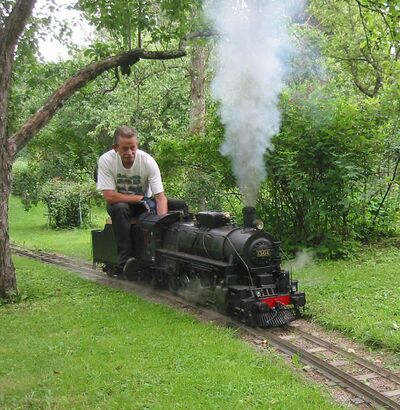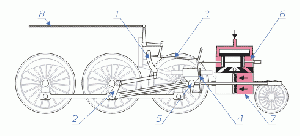Model Engineering
Summary: Model Engineering is the hobby of building functional models which operate on steam. The term used in North America is Live Steam. These models may be radio controlled.
Festivals
A live steam festival is a gathering of people interested in steam technology. Trains, steam rollers and tractors, steam boats and stationary steam engines may be on display, both full-sized and in miniature. Rides may also be offered.
Scale Models and Railroads
The term live steam also refers to a model steam locomotive, or any other steam-operated model that is powered by steam produced by boiling water. Steam rollers and tractors are popular, in 1:4 or 1:3 scale, as are stationary model steam engines, ranging from pocket-size to 1:2 scale.
Ridable, large scale live steam railroading on a backyard railroad is an increasingly popular, but time-consuming and/or expensive hobby. Garden railways, in smaller scales, offer the excitement of real steam engines, but at lower cost, and in less space.
One of the most famous live steam railroads was Walt Disney's Carolwood Pacific Railroad, which inspired Disney to surround his planned Disneyland amusement park with a working, narrow gauge railroad.
The world's largest live steam layout, with over 25 miles (40 km) of trackage is Train Mountain in Chiloquin, Oregon, USA. Another notable layout is the one operated by Los Angeles Live Steamers.
Technology
A live steam locomotive is often an exact, handcrafted scale model. The ridable track gauges range from 2-1/2" to 15", the most popular being in the 4-3/4" to 7-1/2" range. Gauges from 10" (254 mm) and up are called "Miniature Railways" (in the USA these are known as "Grand Scale Railroads"), and are used mostly in amusement park rides and commercial settings.
A wide variety of boiler designs are available, ranging from simple externally fired pot boilers to sophisticated multi-flue internally fired boilers and even superheater boilers usually found only on larger, more complex models.
Construction involves knowledge of metal working, machine tools and other techniques required to fabricate or finish parts during the process of assembling a model. Many castings are available, but require the hobbyist to complete the process using various machine tools.
Fuels
There are several common fuels used to boil water in live steam models, depending on their scale:
Small scales:
- Solid fuel pellets – Produce relatively little heat, but cheap and relatively safe. They are often used on "toy" live steam locomotives such as the range produced by Mamod.
- Methylated spirit, (methanol/ethanol mixture) – Burns hotter than solid fuel, but more dangerous.
- Butane or Propane Gas – Clean burning and safe, relatively expensive to engineer the burners.
- Electricity – Delivered via the track and used to boil the water in an immersion boiler. Traditionally rare as it requires potentially dangerous currents and voltages. However, in 2003, Hornby launched a highly successful range of OO gauge models that run from a 12-volt power supply, a voltage low enough to be safe to touch.
Large scales:
- Oil – A popular fuel for large, ridable trains.
- Propane – Alternative to coal or oil in large-scale models.
All scales:
- Coal – The prototypical fuel for most full-sized steam locomotives, and the preferred fuel for ridable trains. It can be used on boilers down to at least 16mm:1 foot scale. Smaller fireboxes can be difficult to fuel, particularly if the cab is small or crowded.
Live Steam magazine
"Live Steam" is a U.S. magazine, founded in 1966 and devoted to the live steam hobby, as well as to other uses of miniature and full-size steam. Originally, it was a mimeographed newsletter, but soon expanded into magazine format. In 2005, the name was changed to Live Steam & Outdoor Railroading. It is currently published bi-monthly, in full color, with a press run of slightly over 10,000 (Dec. 2004).
External links
- Building Live Steam trains
- Hornby Live Steam
- Live Steam Magazine official website
- A Rideable live steam track in Ft. Myers, FL

